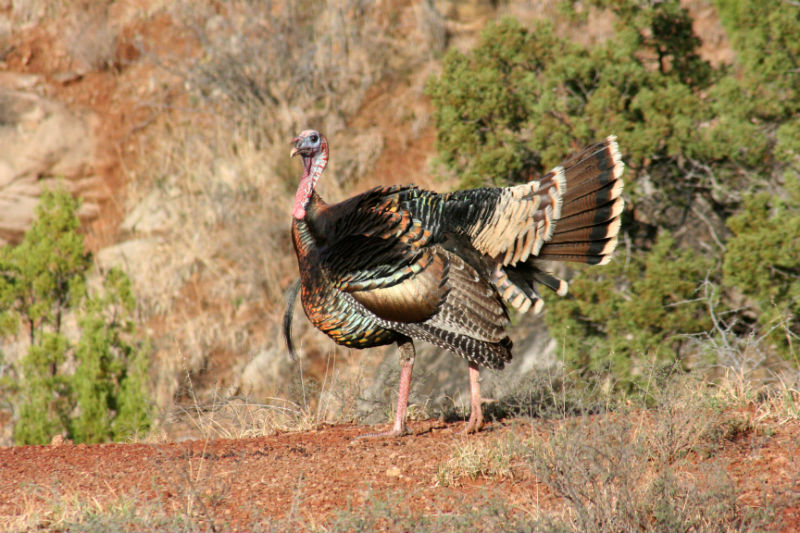I’ve hunted across Texas – from Panhandle shelter belts and Rolling Plains oak mottes to South Texas mesquite thickets and Pineywoods forest cover – and one quarry in particular calls each of them home, providing some of the toughest hunting around: the wild turkey.
Jason Hardin, turkey program leader for the Texas Parks & Wildlife Department, said the overall turkey outlook across the state is as good as it has ever been, noting that there will be no shortage of toms and hens skulking around this fall, a time when most hunters will be focusing on deer.
“There was a lot of moisture this past winter going into early spring. Good moisture for Rio Grande turkeys means early green-up and those hens are going to be in great shape. We had a fair amount of production in 2014 so we had a fair number of juvenile birds out there … mostly adult birds. And they went into the nesting season and the breeding season in great shape,” he said.
Hardin said that spring gobbler hunting was tough in many traditional hot spots, but in a good way.
“If you were out there calling you had a lot of competition (from breeding-ready hens). A lot of hunters were having trouble getting hens in first thing in the morning off the roost. For those hunters that stuck with, early morning or mid-afternoon, you could get a bird,” he said. “What’s good for a turkey isn’t always what’s great for a turkey hunter. We do a fair amount of restoration and so to do that we have to go out and trap turkeys, and it was one of the hardest years to trap turkeys. There was just so much food out there, you couldn’t bait them in. So again not great for our research and restoration efforts but great for the birds.
“We had some hens on their second nesting attempts with 16 eggs in a clutch. That’s just phenomenal. You never think about that for those second nesting attempts. And we had some birds sitting on their third nesting attempt all over Texas. They may only have six or eight eggs, but just the fact that it’s been such a good year green-up-wise and cover-wise, they’ve had a lot of opportunity.”
Hardin noted that heavy rainfall that created dangerous flooding across the Hill Country is good overall for production, but the lingering effects can be detrimental in the short-term outlook.
“All the rain we’ve had (late spring and early summer) has been tough on birds. Typically your birds are going to nest more in the uplands, so a lot of that country that floods, your hens are nesting down there,” he said. “You want a lot of rain heading up to nesting season and then you kind of want it to slow down because those wet hens are real susceptible to predators. So they’re already losing about half of their nests in a good year, and add in the wet hens and the smelly hen syndrome or theory, and you get the idea that a lot of predators are going to find those nests more efficiently. So we’ve lost a lot of nests through that. We’re still going to see some pretty good production this year.”
Hardin said that turkey hunting in general has seen a rise in hunter participation, which can have negative influences on the average Texan looking to bag some birds.
“We’ve actually seen hunter numbers go down but I don’t think that’s necessarily a function of a decline in turkey population as much as it is an increase in the popularity of turkey hunting,” he said. “Ten years ago you could come to Texas and you could hunt just about anywhere for $300, $500. You come to Texas nowadays it’s hard to find a place to hunt that doesn’t cost you a couple of grand. The majority of Texas is privately owned so there’s not a lot of public land out there for people to hunt, especially public lands that are open throughout the turkey season. I think financially is has become a little more difficult so the opportunity is not there as much as it once was.”
“Texas is one of the most popular places to come get your Rio and people will pay top-dollar for it.”
While the rise in turkey hunting costs may keep some hunters from enjoying the pursuit in the spring, the fall is the perfect time to target hens and gobblers since most deer hunters are sitting in great Rio Grande turkey country.
“We have the highest number of Rios, the highest harvest in the nation and the highest number of hunters, so we are the place to be for Rio Grande turkeys,” Hardin said. “Overall in Texas our population is expanding. Historically that I-35 corridor has been a bit of a barrier but now we have those birds on the east side of I-35 and they’re continuing to expand. If you look at it over the span of decades, you can see that it’s a growing population. And just over the last five years in that area of Bastrop south to Goliad, that population has really grown and they’ve expanded their range, so it’s a good time for Rio Grande turkeys.”



















